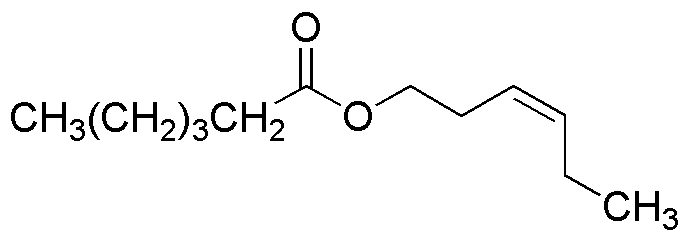cis-3-Hexen-1-yl hexanoate is widely utilized in research focused on:
- Flavor and Fragrance Industry: This compound is commonly used as a flavoring agent in food products and as a fragrance component in perfumes and cosmetics, providing a fresh, green note that enhances sensory appeal.
- Aromatherapy: Its pleasant aroma makes it a popular choice in essential oil blends, contributing to relaxation and mood enhancement in therapeutic settings.
- Food Preservation: Research indicates that this compound may possess antimicrobial properties, making it a potential natural preservative to extend the shelf life of various food products.
- Plant Growth Regulators: In agricultural research, it is studied for its role in influencing plant growth and development, potentially improving crop yields and quality.
- Biotechnology: Its unique chemical properties are explored in the development of biosensors and other innovative applications, aiding in environmental monitoring and analysis.
Informations générales
Propriétés
Sécurité et réglementation
Applications
cis-3-Hexen-1-yl hexanoate is widely utilized in research focused on:
- Flavor and Fragrance Industry: This compound is commonly used as a flavoring agent in food products and as a fragrance component in perfumes and cosmetics, providing a fresh, green note that enhances sensory appeal.
- Aromatherapy: Its pleasant aroma makes it a popular choice in essential oil blends, contributing to relaxation and mood enhancement in therapeutic settings.
- Food Preservation: Research indicates that this compound may possess antimicrobial properties, making it a potential natural preservative to extend the shelf life of various food products.
- Plant Growth Regulators: In agricultural research, it is studied for its role in influencing plant growth and development, potentially improving crop yields and quality.
- Biotechnology: Its unique chemical properties are explored in the development of biosensors and other innovative applications, aiding in environmental monitoring and analysis.
Documents
Fiches de données de sécurité (FDS)
La FDS fournit des informations de sécurité complètes sur la manipulation, le stockage et l’élimination du produit.
Spécifications du produit (PS)
Le PS fournit une description complète des propriétés du produit, notamment sa composition chimique, son état physique, sa pureté et les exigences de stockage. Il détaille également les plages de qualité acceptables et les applications prévues du produit.
Certificats d'analyse (COA)
Recherchez des certificats d'analyse (COA) en saisissant le numéro de lot du produit. Les numéros de lot et de lot se trouvent sur l'étiquette d'un produit, après les mots « Lot » ou « Lot de fabrication ».
Numéro de catalogue
Numéro de lot/série
Certificats d'origine (COO)
Ce certificat d'exploitation confirme le pays dans lequel le produit a été fabriqué, et détaille également les matériaux et composants utilisés et s'il est issu de sources naturelles, synthétiques ou autres sources spécifiques. Ce certificat peut être requis pour les douanes, le commerce et la conformité réglementaire.
Numéro de catalogue
Numéro de lot/série
Fiches de données de sécurité (FDS)
La FDS fournit des informations de sécurité complètes sur la manipulation, le stockage et l’élimination du produit.
DownloadSpécifications du produit (PS)
Le PS fournit une description complète des propriétés du produit, notamment sa composition chimique, son état physique, sa pureté et les exigences de stockage. Il détaille également les plages de qualité acceptables et les applications prévues du produit.
DownloadCertificats d'analyse (COA)
Recherchez des certificats d'analyse (COA) en saisissant le numéro de lot du produit. Les numéros de lot et de lot se trouvent sur l'étiquette d'un produit, après les mots « Lot » ou « Lot de fabrication ».
Numéro de catalogue
Numéro de lot/série
Certificats d'origine (COO)
Ce certificat d'exploitation confirme le pays dans lequel le produit a été fabriqué, et détaille également les matériaux et composants utilisés et s'il est issu de sources naturelles, synthétiques ou autres sources spécifiques. Ce certificat peut être requis pour les douanes, le commerce et la conformité réglementaire.

